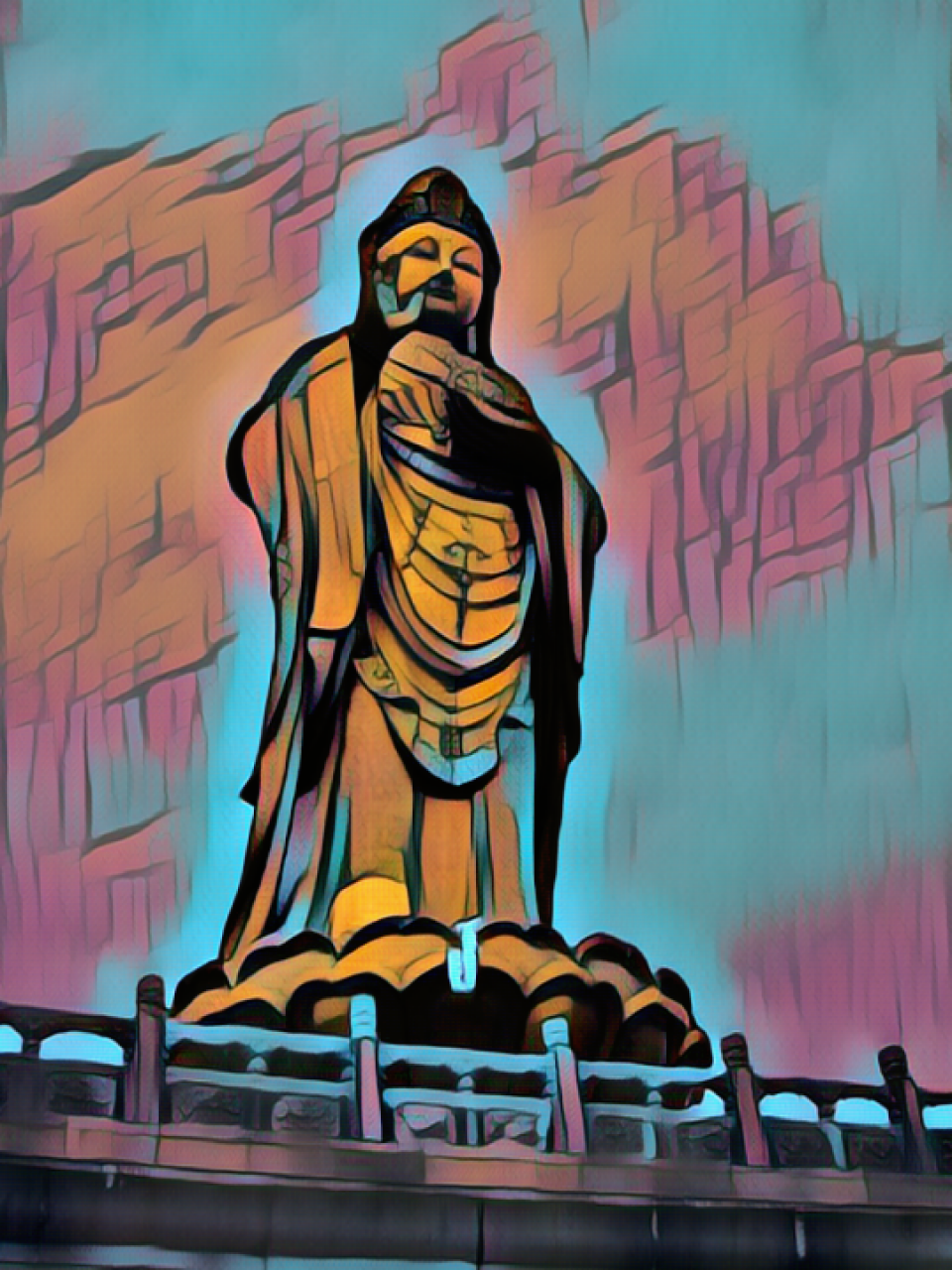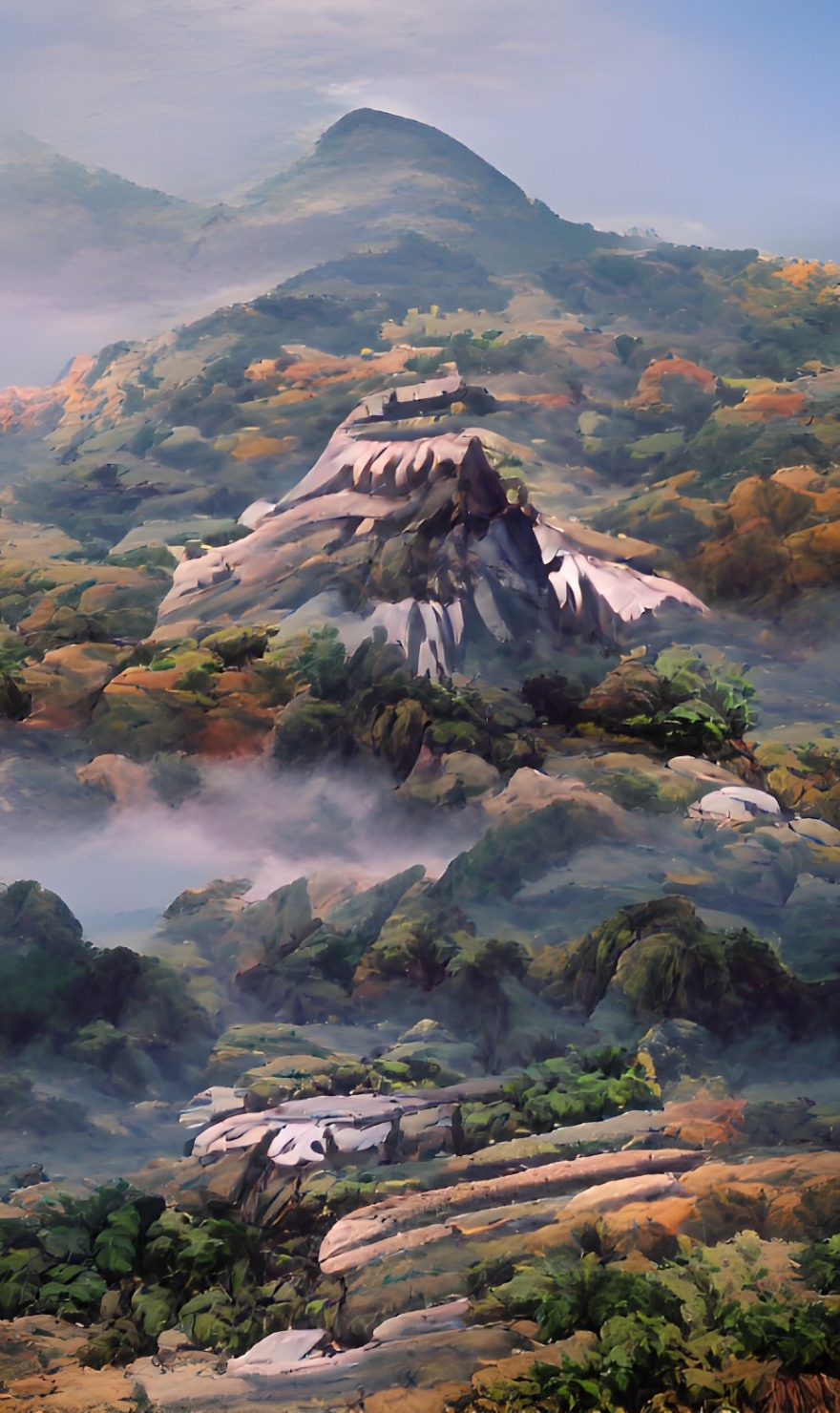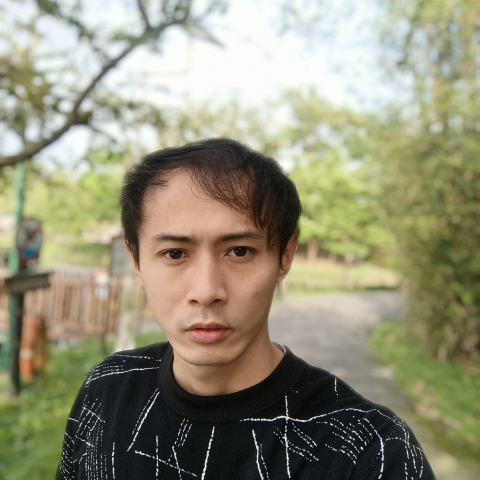



四大佛山 普陀山 觀世音菩薩Bodhisattva Avalokitasvara

$0.50 OSD
Buy4 out of 5 available
Co-creators
-
 星辰大海sea168 Chang, Yi-Chen 張伊辰
星辰大海sea168 Chang, Yi-Chen 張伊辰 - 100.00%
四大佛山 普陀山 觀世音菩薩Bodhisattva Avalokitasvara

Story
普陀山觀世音菩薩 Bodhisattva Avalokitasvara
普陀山是中國浙江省舟山群島中的一個島嶼,也是中國四大佛教名山之一,是觀音菩薩的道場。原名梅岑山,後改以印度補怛落迦山(Potalaka)之名相稱。
普陀山是中國四大佛教名山中唯一座落海上的佛教勝地,具有「海天佛國」的美譽
傳說普陀山曾被秦始皇認定爲蓬萊山,來此求長生不老藥,此山也因為被稱為「海上仙山」,歷史上有諸多道士慕名前來,著名道士梅福(字子真)也在其列。相傳梅福漢平帝元始年間到此山隱居,故此山自西漢至宋代時叫梅岑山。847年即唐代時,也有梵僧(天竺國僧人)來山上的潮音洞邊焚指供佛,引起觀世音菩薩現身授寶,後來潮音洞旁常有信士來此效仿焚指,引起僧團和官府的禁止,告誡禁止燃指的石碑至今仍在。故此山古來已是佛道信仰的聖地。
傳說,西元858年,唐朝大中十二年,日本臨濟宗高僧慧鍔參訪五臺山,並請得一尊觀音菩薩像準備回國,行至現在的舟山群島普陀山要坐船離島,突然海上狂風起,巨浪沖天,慧鍔法師只好停下待風浪平息再出發。翌日,慧鍔準備再度啟程,豈料海上忽然又升起白霧,擋住前行視線,他左右繞道避開霧氣,卻鬼使神差又繞回島上。第三日,終於天氣晴朗,慧鍔又要出發,可是烏雲忽然蔽日,眼看又要風浪大作,慧鍔心想不宜久留,強行出海,可是越往前風浪越大,驀然海上升起諸多鐵蓮花圍住行船,慧鍔大驚,請出觀音菩薩像祈告指明前路,此時,海中鉆出一頭鐵牛,吞掉鐵蓮花,一條海路出現在慧鍔的眼前。慧鍔的船一路跟隨,駛進普陀山。此後,慧鍔感歎「觀音菩薩不肯離去此地」,便在普陀山建起不肯去觀音院,此山也被視作觀音菩薩的道場而開始流行。
宋代時,人們見此山光明清淨,多有小白花,符合《華嚴經》上對觀音菩薩道場普陀洛迦山(補怛洛伽山)的描述,且傳說此地多有觀音菩薩顯聖的瑞相,便認定此山就是普陀洛迦山,也就漸漸改名為普陀洛迦山。再後來,當地又將這裡兩座大山分別叫做普陀山和珞珈山(洛伽山),導致普陀洛迦山變成由兩座山峰構成,但一般仍稱為普陀山作為簡稱
普陀観音菩薩
Mount Putuo Guanyin Bodhisattva
Mount Putuo is an island in the Zhoushan Archipelago in Zhejiang Province, China. It is also one of the four famous Buddhist mountains in China. It is the dojo of Guanyin Bodhisattva. Formerly known as Mt. Metzen, it was later changed to the name of Potalaka in India.
Mount Putuo is the only Buddhist resort located on the sea among the four famous Buddhist mountains in China, and has the reputation of "Buddha Country in the Sea and Heaven".
Legend has it that Putuo Mountain was once identified as Penglai Mountain by Qin Shihuang, who came here to seek the elixir of life. This mountain is also known as the "Sea Immortal Mountain". Many Taoists in history came here, including the famous Taoist Mei Fu (Zizhen). its columns. Legend has it that Emperor Meifu of Han Dynasty came to this mountain to live in seclusion during the Yuanshi period, so the mountain was called Meicen Mountain from the Western Han Dynasty to the Song Dynasty. In 847, in the Tang Dynasty, there were also Buddhist monks (monks from Tianzhu Kingdom) who came to the Chaoyin Cave on the mountain to burn their fingers to offer Buddha, which caused the Avalokitesvara Bodhisattva to appear to give the treasure. The official prohibition, the stele that warns against burning the finger is still there. Therefore, the mountain has been a holy place for Buddhist and Taoist beliefs since ancient times.
Legend has it that in AD 858, in the 12th year of the Tang Dynasty, the eminent monk Hui E of the Rinzai sect of Japan visited Mount Wutai and invited a statue of Guanyin Bodhisattva to return to China. The wind was blowing and the waves were soaring into the sky, so Master Hui E had to stop and wait for the wind and waves to calm down before setting off. The next day, Hui E was about to set off again. Unexpectedly, a white fog suddenly rose from the sea, blocking his vision. He took a detour to avoid the fog, but he went back to the island again. On the third day, the weather was finally clear and Hui E was about to set off again, but the dark clouds suddenly covered the sun, and the storm was about to break out. Hui E thought that it was not advisable to stay for a long time and forcibly set out to the sea, but the wind and waves became stronger as he went forward, and suddenly a lot of iron rose from the sea. The lotus surrounded the boat, Huie was shocked, and asked the Avalokitesvara Bodhisattva statue to pray to point out the way forward. At this time, an iron bull emerged from the sea, swallowed the iron lotus, and a sea road appeared in front of Huie's eyes. Hui'e's boat followed and sailed into Putuo Mountain. After that, Hui E sighed that "Guanyin Bodhisattva refuses to leave this place", so he built the Guanyin Temple on Mount Putuo, which was also regarded as the dojo of Guanyin Bodhisattva and became popular.
In the Song Dynasty, people saw that this mountain was bright and clean, with many small white flowers, which was in line with the description of the Guanyin Bodhisattva Dojo Putuoluojia Mountain (Putuoluojia Mountain) in the "Huayan Sutra", and it is said that there are many auspiciousness of Guanyin Bodhisattva manifesting here. After seeing this, he decided that this mountain was Putuo Luojia Mountain, and gradually changed its name to Putuo Luojia Mountain. Later, the two mountains here were called Putuo Mountain and Luojia Mountain (Luojia Mountain) respectively, resulting in Putuo Luojia Mountain becoming composed of two peaks, but generally still called Putuo Mountain as the abbreviation.
普陀山は、中国浙江省舟山群島にある島で、中国の有名な仏教山の1つであり、観音菩薩の道場でもあります。以前はメッツェン山として知られていましたが、後にインドでは補陀落の名前に変更されました。
普陀山は、中国の4つの有名な仏教山の中で海に面した唯一の仏教リゾートであり、「海と天国の仏国」としての評判があります。
普陀山は、生命の秘薬を求めてここにやってきた秦始皇帝によってかつて蓬萬山と特定されたと言われています。この山は「海の不滅の山」としても知られています。有名なタオイストを含む多くのタオイストがここにやって来ました。 Mei Fu(Zizhen)。その列。元始天尊時代に漢王朝の梅風皇帝がこの山に隔離されてやって来たという伝説があり、漢王朝から宋王朝にかけて明泉山と呼ばれていました。 847年、唐の時代には、山のチャオイン洞窟に指を燃やして仏を捧げるためにやって来た僧侶(天竺王国の僧侶)もいました。禁止、指を焼くことに対して警告する石碑はまだそこにあります。したがって、この山は古くから仏教や道教の信仰の聖地でした。
唐王朝12年の西暦858年、臨済宗の著名な僧侶ホイEが五台を訪れ、観音菩薩像を中国に招きました。風が吹いて波が吹いていました。空に舞い上がっていたので、マスターホイEは立ち止まり、風と波が落ち着くのを待ってから出発しました。翌日、許軼はまた出発しようとしていたが、突然海から白い霧が立ち、視界を遮った。霧を避けるために迂回したが、再び島に戻った。三日目、ようやく天気が良くなり、ホイEが再び出発しようとしたが、突然暗い雲が太陽を覆い、嵐が吹き荒れそうになった。ホイEは、久しぶりに海に出たが、進むにつれて風と波が強くなり、突然海からたくさんの鉄が浮かび上がり、蓮が船を囲み、ホイエはショックを受け、観世音菩薩にこの時、海から鉄の雄牛が現れて鉄の蓮を飲み込み、ホイエの目の前に海路が現れました。ホイエの船が続いて普陀山に出航した。その後、ホイ・エは「観音菩薩はこの場所を離れることを拒否する」とため息をつき、普陀山に観音堂を建てました。これは観音菩薩の道場とも呼ばれ、人気を博しました。
宋代では、この山は明るくきれいで、小さな白い花がたくさんあり、「華厳経」の観音菩薩道場プトゥオルオジア山(プトゥオルオジア山)の描写と一致していると言われています。観音菩薩の縁起が多く、ここに現れたのを見て、この山をプトゥオルオジア山と判断し、徐々にプトゥオルオジア山に改名しました。後に、ここの2つの山はそれぞれ普陀山と普陀山(普陀山)と呼ばれ、普陀山は2つの山で構成されましたが、一般的には普陀山と呼ばれています。
中國佛教四大名山,是漢傳佛教傳統認為的四大菩薩道場。浙江普陀山是觀音菩薩的道場,山西五台山是文殊菩薩的道場,四川峨眉山是普賢菩薩的道場,安徽九華山為地藏菩薩道場。以上四處也合稱「四大菩薩道場」。
普陀山:位於浙江省舟山市普陀區,為觀世音菩薩道場。此山原名梅岑山,因不肯去觀音的傳說而聞名,被認為和經中授記的印度普陀洛迦山一樣神聖,自古觀世音菩薩常在此山顯聖,靈感事跡數不勝數,因此漸成為觀音菩薩的應化道場。
五台山:位於山西省忻州市五台縣,為文殊菩薩道場。又名清涼山、五頂山,爲經中授記文殊菩薩常住道場。
峨嵋山:位於四川省樂山市峨眉山市,為普賢菩薩道場。傳說古人在此山看到騎六牙白象的普賢菩薩,故作為普賢菩薩的應化道場。山上金頂風景秀麗,日出雲海爲一大特色。
九華山:位於安徽省池州市青陽縣,為地藏菩薩道場。傳說朝鮮半島新羅國王子金地藏來此常住,曾顯現神通用袈裟將整山包裹,得到此山地主的供養;因圓寂後顯骨節如鎖的瑞相,被認為是地藏菩薩的化身,故此山也稱爲地藏菩薩道場。
四大佛山之中,五台山的佛寺建築最為雄偉、密集,漢傳佛教、藏傳佛教建築匯聚於此,佛像雕塑的建造也是最為精美的,為四大佛山之首。有人還把四大佛山視為佛教的「四大」結聚。這「四大」又稱為「四界」,指的是地、水、火、風四種物質現象構成的基本元素。佛教認為,世界萬物均由「四大元素」組成,宣揚所謂的「四大皆空」其實就是指宇宙間的一切,包括人身在內,都是虛幻不實的。中國佛教教徒也將四大道場說成是「四大」的體現。《普陀山志》中記載:
“佛經稱地藏、觀音、普賢、文殊諸佛道場,曰地、水、火、風,為四大結聚。九華,地也;普陀,水也;峨眉,火也;五台,風也。
The Four Famous Mountains of Chinese Buddhism are the Four Great Bodhisattva Dojos considered by the Chinese Buddhist tradition. Putuo Mountain in Zhejiang is the dojo of Guanyin Bodhisattva, Wutai Mountain in Shanxi is the dojo of Manjushri Bodhisattva, Mount Emei in Sichuan is the dojo of Samantabhadra Bodhisattva, and Jiuhua Mountain in Anhui is the dojo of Ksitigarbha Bodhisattva. The above four places are also collectively referred to as the "Four Great Bodhisattva Dojos".
Putuo Mountain: Located in Putuo District, Zhoushan City, Zhejiang Province, it is the dojo of Guanyin Bodhisattva. This mountain, formerly known as Mount Meichen, is famous for the legend of refusing to go to Avalokitesvara. It is considered to be as sacred as Mount Putuo Luojia in India, which is prophesied in the scriptures. Since ancient times, Avalokitesvara Bodhisattva has often appeared on this mountain. There are countless inspirations and deeds, so it gradually became the Avalokitesvara Bodhisattva. of the Dojo.
Wutai Mountain: Located in Wutai County, Xinzhou City, Shanxi Province, it is the Manjusri Bodhisattva Dojo. Also known as Qingliang Mountain and Wuding Mountain, it is the permanent residence of Manjushri Bodhisattva in the scriptures.
Mount Emei: Located in Emeishan City, Leshan City, Sichuan Province, it is the Dojo of Puxian Bodhisattva. Legend has it that the ancients saw Samantabhadra Bodhisattva riding a white elephant with six tusks on this mountain, so it was regarded as the Yinghua Dojo of Samantabhadra. The golden top of the mountain has beautiful scenery, and the sunrise and sea of clouds are a major feature.
Jiuhua Mountain: Located in Qingyang County, Chizhou City, Anhui Province, it is the dojo of Ksitigarbha Bodhisattva. Legend has it that King Jinjizo, the prince of Silla, the Korean peninsula, came to live here permanently. He once appeared to wrap the entire mountain in a cassock, and received the offerings from the mountain owner. The mountain is also known as the Jizo Bodhisattva Dojo.
Among the Four Foshan Mountains, Wutai Mountain has the most majestic and dense Buddhist temple buildings. The buildings of Chinese Buddhism and Tibetan Buddhism converge here. The construction of Buddha statues is also the most exquisite, and it is the first of the four Foshan Mountains. Some people also regard the Four Great Foshans as the gathering of the "Four Four" of Buddhism. These "four elements", also known as the "four elements", refer to the basic elements that constitute the four material phenomena of earth, water, fire, and wind. Buddhism believes that all things in the world are composed of the "four elements", and the so-called "four elements are empty" actually means that everything in the universe, including the human body, is illusory and unreal. Chinese Buddhists also refer to the Four Great Daochang as the embodiment of the "Four Great". "Putuo Mountain Chronicle" records:
"The Buddhist scriptures call Ksitigarbha, Avalokitesvara, Puxian, and Manjushri the Buddhist Taoist sites, which are called earth, water, fire, and wind. wind also.
中国仏教の4つの有名な山は、中国の仏教の伝統によって考慮されている4つの偉大な菩薩道場です。浙江省の普陀山は観音菩薩の道場、山西の呉台山は文殊菩薩の道場、四川の峨眉山はサマンタバドラ菩薩の道場、安徽の九華山は地蔵菩薩の道場です。上記の4つの場所は、まとめて「四大菩薩道場」とも呼ばれます。
普陀山:浙江省舟山市普陀山区に位置し、観音菩薩の道場です。かつては観音菩薩と呼ばれていたこの山は、観音菩薩に行くことを拒否したという伝説で有名で、聖典で預言されているインドの普陀山と同じくらい神聖であると考えられています。この山に現れ、数え切れないほどのインスピレーションを持っているので、彼は徐々に道場の観音菩薩になりました。
五台山:山西省忻州市五台県にある文殊菩薩道場です。 QingliangMountainおよびWudingMountainとしても知られ、経典にある文殊菩薩の永住権です。
峨眉山:四川省楽山市峨眉山市に位置し、ホ仙菩薩の道場です。普賢菩薩がこの山で六本の牙を持った白象に乗っているのを見たという伝説があり、普賢菩薩の道場とされていました。山の黄金の頂上は美しい景色があり、日の出と雲海が大きな特徴です。
九華山:安徽省池州市青陽県にある地蔵菩薩の道場です。朝鮮半島の新羅の王子である神子蔵王が恒久的にここに住むようになったという伝説があります。彼はかつて山全体をカソックで包んだように見え、山の所有者から提供されました。この山は地蔵菩薩としても知られています。道場。
五台山の中で最も雄大で密集した仏教寺院の建物があり、中国仏教とチベット仏教の建物がここに集まっています。仏像の建設も最も精巧で、4つの佛山の最初のものです。 。一部の人々はまた、四大フォーシャンを仏教の「四四」の集まりと見なしています。これらの「4つの要素」は、「4つの要素」とも呼ばれ、地球、水、火、風の4つの物質的な現象を構成する基本的な要素を指します。仏教は、世界のすべてが「4つの要素」で構成されていると信じており、いわゆる「4つの要素が空である」とは、実際には人体を含む宇宙のすべてが幻想的で非現実的であることを意味します。中国の仏教徒はまた、四大大昌を「四大」の化身と呼んでいます。 「普陀山クロニクル」の記録:
「仏典では、地蔵菩薩、観世音菩薩、ホ仙、文殊菩薩の仏陀遺跡と呼ばれ、4つの主要な集まりです。地蔵、地球、プトゥオ、水、エメイ、火、文殊菩薩、風も。
四大佛山 九華山 地藏菩薩Jiuhua Shan Kṣitigarbha
https://www.oursong.com/vibe/ywvbzdgw
四大佛山 峨眉山 普賢菩薩 Samantabhadra
https://www.oursong.com/vibe/lrogxjxr
四大佛山 五台山 文殊菩薩 Mount Wutai Manjusri Bodhisattva
https://www.oursong.com/vibe/grqbeqmw
四大佛山 普陀山 觀世音菩薩Bodhisattva Avalokitasvara
https://www.oursong.com/vibe/armzalyw
Tags
Created on 2022/03/30 15:06:07 UTC
Contract Address
0x47AC3b44eC854bC513Ff99fb8AAC7738fa52acD7
- Token ID
- 53334
- Chain
- ThunderCore
- Token Standard
- TT1155
- Metadata URL
- https://oursong.com/project/erc1155token-meta/53334.json